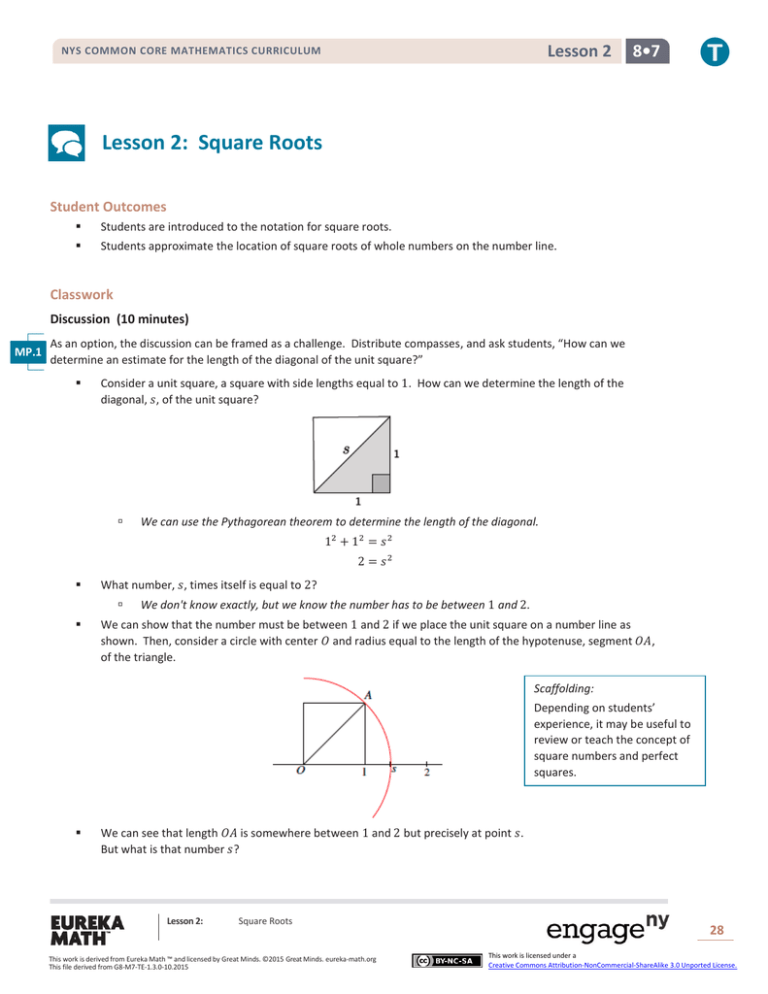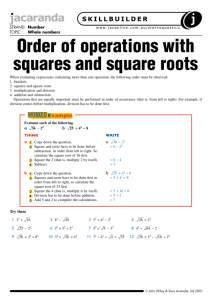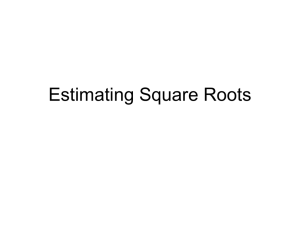Lesson 2: Square Roots
advertisement

Lesson 2 NYS COMMON CORE MATHEMATICS CURRICULUM 8•7 Lesson 2: Square Roots Student Outcomes Students are introduced to the notation for square roots. Students approximate the location of square roots of whole numbers on the number line. Classwork Discussion (10 minutes) MP.1 As an option, the discussion can be framed as a challenge. Distribute compasses, and ask students, “How can we determine an estimate for the length of the diagonal of the unit square?” Consider a unit square, a square with side lengths equal to 1. How can we determine the length of the diagonal, 𝑠, of the unit square? We can use the Pythagorean theorem to determine the length of the diagonal. 12 + 12 = 𝑠 2 2 = 𝑠2 What number, 𝑠, times itself is equal to 2? We don't know exactly, but we know the number has to be between 1 and 2. We can show that the number must be between 1 and 2 if we place the unit square on a number line as shown. Then, consider a circle with center 𝑂 and radius equal to the length of the hypotenuse, segment 𝑂𝐴, of the triangle. Scaffolding: Depending on students’ experience, it may be useful to review or teach the concept of square numbers and perfect squares. We can see that length 𝑂𝐴 is somewhere between 1 and 2 but precisely at point 𝑠. But what is that number 𝑠? Lesson 2: Square Roots This work is derived from Eureka Math ™ and licensed by Great Minds. ©2015 Great Minds. eureka-math.org This file derived from G8-M7-TE-1.3.0-10.2015 28 This work is licensed under a Creative Commons Attribution-NonCommercial-ShareAlike 3.0 Unported License. NYS COMMON CORE MATHEMATICS CURRICULUM There are other numbers on the number line between the integers. Some of the square roots of whole numbers are equal to whole numbers, but most lie between the integers on the number line. A positive number whose square is equal to a positive number 𝑏 is denoted by the symbol √𝑏. The symbol √𝑏 automatically denotes a positive number (e.g., √4 is always 2, not −2). The number √𝑏 is called a positive square root of 𝑏. We will soon learn that it is the positive square root (i.e., there is only one). Scaffolding: Students may benefit from an oral recitation of square roots of perfect squares here and throughout the module. Consider some repeated quick practice, calling out, for example: “What is the square root of 81?” and “What is the square root of 100?” Ask for choral or individual responses. Scaffolding: If students are struggling with the concept of a square root, it may help to refer to visuals that relate numbers and their squares. Showing this visual What is √25, that is, the positive square root of 25? Explain. 8•7 From our work with exponents, specifically squared numbers, we know that 2 is not a perfect square. Thus, the length of the diagonal must be between the two integers 1 and 2, and that is confirmed on the number line. To determine the number 𝑠, we should look at that part of the number line more closely. To do so, we need to discuss what kinds of numbers lie between the integers on a number line. What do we already know about those numbers? Lead a discussion about the types of numbers found between the integers on a number line. Students should identify that rational numbers, such as fractions and decimals, lie between the integers. Have students give concrete examples of numbers found between the integers 1 and 2. Consider asking students to write a rational number, 𝑥, so that 1 < 𝑥 < 2, on a sticky note and then to place it on a number line drawn on a poster or white board. At the end of this part of the discussion, make clear that all of the numbers students identified are rational and in the familiar forms of fractions, mixed numbers, and decimals. Then, continue with the discussion below about square roots. Lesson 2 The positive square root of 25 is 5 because 52 = 25. What is √9, that is, the positive square root of 9? Explain. The positive square root of 9 is 3 because 32 = 9. Exercises 1–4 (5 minutes) and asking questions (e.g., “What is the square root of 9?”) builds students’ understanding of square roots through their understanding of squares. Students complete Exercises 1–4 independently. Exercises 1–4 1. Determine the positive square root of 𝟖𝟏, if it exists. Explain. The square root of 𝟖𝟏 is 𝟗 because 𝟗𝟐 = 𝟖𝟏. 2. Determine the positive square root of 𝟐𝟐𝟓, if it exists. Explain. The square root of 𝟐𝟐𝟓 is 𝟏𝟓 because 𝟏𝟓𝟐 = 𝟐𝟐𝟓. 3. Determine the positive square root of −𝟑𝟔, if it exists. Explain. The number −𝟑𝟔 does not have a square root because there is no number squared that can produce a negative number. 4. Determine the positive square root of 𝟒𝟗, if it exists. Explain. The square root of 𝟒𝟗 is 𝟕 because 𝟕𝟐 = 𝟒𝟗. Lesson 2: Square Roots This work is derived from Eureka Math ™ and licensed by Great Minds. ©2015 Great Minds. eureka-math.org This file derived from G8-M7-TE-1.3.0-10.2015 29 This work is licensed under a Creative Commons Attribution-NonCommercial-ShareAlike 3.0 Unported License. NYS COMMON CORE MATHEMATICS CURRICULUM Lesson 2 8•7 Discussion (15 minutes) Now, back to our unit square. We said that the length of the diagonal is 𝑠, and 𝑠 2 = 2. Now that we know about square roots, we can say that the length of 𝑠 is √2 and that the number √2 is between integers 1 and 2. Let’s look at the number line more generally to see if we can estimate the value of √2. Take a number line from 0 to 4: Discussion Place the numbers √1, √4, √9, and √16 on the number line, and explain how you knew where to place them. Solutions are shown below in red. Place the numbers √2 and √3 on the number line. Be prepared to explain your reasoning. Solutions are shown below in red. Students should reason that the numbers √2 and √3 belong on the number line between √1 and √4. They might be more specific and suggest that the numbers √2 and √3 sit equally spaced in the 1 3 2 3 interval between 1 and 2. This idea suggests that 1 might be a good approximation for √2 and 1 for √3. Of course, this suggested spacing is just speculation for now. MP.3 Place the numbers √5, √6, √7, and √8 on the number line. Be prepared to explain your reasoning. Solutions are shown below in red. The discussion about placement should be similar to the previous one. Lesson 2: Square Roots This work is derived from Eureka Math ™ and licensed by Great Minds. ©2015 Great Minds. eureka-math.org This file derived from G8-M7-TE-1.3.0-10.2015 30 This work is licensed under a Creative Commons Attribution-NonCommercial-ShareAlike 3.0 Unported License. Lesson 2 NYS COMMON CORE MATHEMATICS CURRICULUM 8•7 Place the numbers √10, √11, √12, √13, √14, and √15 on the number line. Be prepared to explain your reasoning. Solutions are shown below in red. The discussion about placement should be similar to the previous one. MP.3 Our work on the number line shows that there are many more square roots of whole numbers that are not perfect squares than those that are perfect squares. On the number line above, we have four perfect square numbers and twelve that are not! After we do some more work with roots, in general, we will cover exactly how to describe these numbers and how to approximate their values with greater precision. For now, we will estimate their locations on the number line using what we know about perfect squares. Exercises 5–9 (5 minutes) Students complete Exercises 5–9 independently. Calculators may be used for approximations. Exercises 5–9 Determine the positive square root of the number given. If the number is not a perfect square, determine which whole number the square root would be closest to, and then use guess and check to give an approximate answer to one or two decimal places. 5. √𝟒𝟗 𝟕 6. √𝟔𝟐 The square root of 𝟔𝟐 is close to 𝟖. The square root of 𝟔𝟐 is approximately 𝟕. 𝟗 because 𝟕. 𝟗𝟐 = 𝟔𝟐. 𝟒𝟏. 7. √𝟏𝟐𝟐 The square root of 𝟏𝟐𝟐 is close to 𝟏𝟏. Students may guess a number between 𝟏𝟏 and 𝟏𝟏. 𝟏 because 𝟏𝟏. 𝟎𝟓𝟐 = 𝟏𝟐𝟐. 𝟏𝟎𝟐𝟓. 8. √𝟒𝟎𝟎 𝟐𝟎 9. Which of the numbers in Exercises 5–8 are not perfect squares? Explain. The numbers 𝟔𝟐 and 𝟏𝟐𝟐 are not perfect squares because there is no integer 𝒙 to satisfy 𝒙𝟐 = 𝟔𝟐 or 𝒙𝟐 = 𝟏𝟐𝟐. Lesson 2: Square Roots This work is derived from Eureka Math ™ and licensed by Great Minds. ©2015 Great Minds. eureka-math.org This file derived from G8-M7-TE-1.3.0-10.2015 31 This work is licensed under a Creative Commons Attribution-NonCommercial-ShareAlike 3.0 Unported License. NYS COMMON CORE MATHEMATICS CURRICULUM Lesson 2 8•7 Closing (5 minutes) Summarize, or ask students to summarize, the main points from the lesson: We know that there are numbers on the number line between the integers. The ones we looked at in this lesson are square roots of whole numbers that are not perfect squares. We know that when a positive number 𝑥 is squared and the result is 𝑏, then √𝑏 is equal to 𝑥. We know how to approximate the square root of a whole number and its location on a number line by figuring out which two perfect squares it is between. Lesson Summary A positive number whose square is equal to a positive number 𝒃 is denoted by the symbol √𝒃. The symbol √𝒃 automatically denotes a positive number. For example, √𝟒 is always 𝟐, not −𝟐. The number √𝒃 is called a positive square root of 𝒃. The square root of a perfect square of a whole number is that whole number. However, there are many whole numbers that are not perfect squares. Exit Ticket (5 minutes) Lesson 2: Square Roots This work is derived from Eureka Math ™ and licensed by Great Minds. ©2015 Great Minds. eureka-math.org This file derived from G8-M7-TE-1.3.0-10.2015 32 This work is licensed under a Creative Commons Attribution-NonCommercial-ShareAlike 3.0 Unported License. Lesson 2 NYS COMMON CORE MATHEMATICS CURRICULUM Name 8•7 Date Lesson 2: Square Roots Exit Ticket 1. Write the positive square root of a number 𝑥 in symbolic notation. 2. Determine the positive square root of 196. Explain. 3. The positive square root of 50 is not an integer. Which whole number does the value of √50 lie closest to? Explain. 4. Place the following numbers on the number line in approximately the correct positions: √16, √9, √11, and 3.5. Lesson 2: Square Roots This work is derived from Eureka Math ™ and licensed by Great Minds. ©2015 Great Minds. eureka-math.org This file derived from G8-M7-TE-1.3.0-10.2015 33 This work is licensed under a Creative Commons Attribution-NonCommercial-ShareAlike 3.0 Unported License. NYS COMMON CORE MATHEMATICS CURRICULUM Lesson 2 8•7 Exit Ticket Sample Solutions 1. Write the square root of a number 𝒙 in symbolic notation. √𝒙 2. Determine the positive square root of 𝟏𝟗𝟔. Explain. √𝟏𝟗𝟔 = 𝟏𝟒 because 𝟏𝟒𝟐 = 𝟏𝟗𝟔. 3. The positive square root of 𝟓𝟎 is not an integer. Which whole number does the value √𝟓𝟎 lie closest to? Explain. √𝟓𝟎 is between 𝟕 and 𝟖 but closer to 𝟕. The reason is that 𝟕𝟐 = 𝟒𝟗, and 𝟖𝟐 = 𝟔𝟒. The number 𝟓𝟎 is between 𝟒𝟗 and 𝟔𝟒 but closer to 𝟒𝟗. Therefore, the square root of 𝟓𝟎 is close to 𝟕. 4. Place the following numbers on the number line in approximately the correct positions: √𝟏𝟔, √𝟗, √𝟏𝟏, and 𝟑. 𝟓. Solutions are shown in red below. Problem Set Sample Solutions Determine the positive square root of the number given. If the number is not a perfect square, determine the integer to which the square root would be closest. 1. √𝟏𝟔𝟗 𝟏𝟑 2. √𝟐𝟓𝟔 𝟏𝟔 3. √𝟖𝟏 𝟗 4. √𝟏𝟒𝟕 The number 𝟏𝟒𝟕 is not a perfect square. It is between the perfect squares 𝟏𝟒𝟒 and 𝟏𝟔𝟗 but closer to 𝟏𝟒𝟒. Therefore, the square root of 𝟏𝟒𝟕 is close to 𝟏𝟐. 5. √𝟖 The number 𝟖 is not a perfect square. It is between the perfect squares 𝟒 and 𝟗 but closer to 𝟗. Therefore, the square root of 𝟖 is close to 𝟑. Lesson 2: Square Roots This work is derived from Eureka Math ™ and licensed by Great Minds. ©2015 Great Minds. eureka-math.org This file derived from G8-M7-TE-1.3.0-10.2015 34 This work is licensed under a Creative Commons Attribution-NonCommercial-ShareAlike 3.0 Unported License. NYS COMMON CORE MATHEMATICS CURRICULUM 6. Lesson 2 8•7 Which of the numbers in Problems 1–5 are not perfect squares? Explain. The numbers 𝟏𝟒𝟕 and 𝟖 are not perfect squares because there is no integer 𝒙 so that 𝒙𝟐 = 𝟏𝟒𝟕 or 𝒙𝟐 = 𝟖. 7. Place the following list of numbers in their approximate locations on a number line. √𝟑𝟐, √𝟏𝟐, √𝟐𝟕, √𝟏𝟖, √𝟐𝟑, and √𝟓𝟎 Answers are noted in red. 8. Between which two integers will √𝟒𝟓 be located? Explain how you know. The number 𝟒𝟓 is not a perfect square. It is between the perfect squares 𝟑𝟔 and 𝟒𝟗 but closer to 𝟒𝟗. Therefore, the square root of 𝟒𝟓 is between the integers 𝟔 and 𝟕 because √𝟑𝟔 = 𝟔 and √𝟒𝟗 = 𝟕 and √𝟑𝟔 < √𝟒𝟓 < √𝟒𝟗. Lesson 2: Square Roots This work is derived from Eureka Math ™ and licensed by Great Minds. ©2015 Great Minds. eureka-math.org This file derived from G8-M7-TE-1.3.0-10.2015 35 This work is licensed under a Creative Commons Attribution-NonCommercial-ShareAlike 3.0 Unported License.






